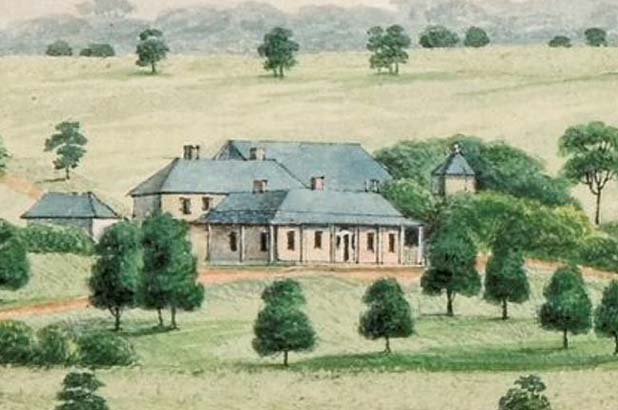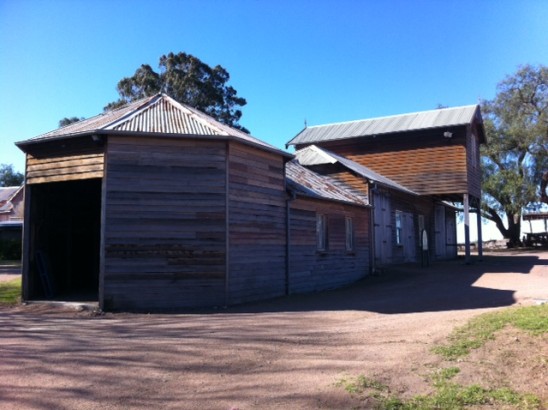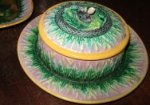Art, archaeology and a cook’s curiosity all add up to the conclusion that the Macarthurs were smoking more than just tobacco at Elizabeth Farm.
A lost colonial smokehouse
The hexagonal building popping up between the trees to the right of the main house in this ‘zoomed in’ detail (above) of Joseph Lycett’s painting of Elizabeth Farm is typical of a domestic smokehouse: not for gentlemen with their tobacco pipes, but to cure and preserve food such as bacon, hams, sausages and, quite probably at Parramatta with its proximity to the river, fish and eels.
Smoking methods
Smoking is an ancient means of preserving foods, which at the same time alters and enhances flavour. There are two types of smoking:
- hot smoking, where foods cook in the heat as they smoke and
- cold smoking, where food is cured with salt to extract excess moisture and then hung in a dry place which has good airflow, so that wood smoke can be conducted around it.
For small scale smoking, the kitchen chimney was used by suspending the semi-cured meat, in a cavity designed for the purpose, high above the cooking flame and any moisture produced from cooking pots. Larger scale smoking operations called for a dedicated structure where many pieces of food could be hung or placed on racks. The smoke was conducted into the room via pipes that connected to a fire pit outside the building itself. Combined with the initial salting process, the smoky environment helps to dry out the meat and the natural chemicals that occur in the smoke inhibit bacterial growth in the food, enabling it to keep for an extended period. This is why delicatessens and continental butcheries can have certain meats hanging in the open air without refrigeration.
The Macarthurs’ smokehouses
Although the structure has not survived, Lycett’s painting indicates that the Macarthurs had a smokehouse at Elizabeth Farm. Further evidence was found when an archaeological excavation revealed clay pipes under a section in the courtyard area adjoining the house, where the drip stone now stands. The Macarthur family’s property at Camden included Belgenny Farm, which also had a smokehouse (you can still visit the farm today). Also hexagonal, this smokehouse was originally free-standing but was later connected to other food-processing workshops. Although it hasn’t been in operation for decades, blackened timbers betray its use for smoking pork that was raised on the farm (see photo below).
Home smoking
While cold-smoking to preserve food is a specialised field, and there are many books and instruction manuals that can teach you how, I don’t feel qualified to attempt it. But hot-smoking is remarkably simple and adds lovely flavour to a variety of foods. As part of the Colonial Gastronomy series of workshops at Elizabeth Farm we tried our hands at smoking oysters, ocean trout and eggs with great success.
There are a number of options for home-smoking that do not involve complicated equipment – although I do suggest you use an outside burner – the process does involve quite a bit of smoke!
Essentially, you need a vessel that can sit over a flame, has a tight fitting lid, and that is large and deep enough to place a rack at least a few centimetres above the base. It’s likely that the vessel will blacken so maybe don’t use your very best quality baking pan. I find a steel wok is ideal if you have a wok burner on your barbeque, however I’ve had great success using disposable aluminum foil trays and even an old electric skillet. You’ll also need lots of good quality aluminium foil, tongs and oven gloves.
There are many different recipes for a smoking mixture, that is intentionally burnt to create the smoke. I prefer to use a mix of fragrant tea leaves and brown sugar, sometimes embellished with spices (see recipe below). The mixture is sprinkled across the base of the smoker and heated to smoking point before the rack of food is placed over it.
Create your own ‘home smoker’
Line the base of your chosen vessel with three layers of good quality aluminium foil. If you’re using a flat based vessel, you will need to form a stand to raise the rack of food up off the base. Scrunched up balls of foil work well, flattened at the base so that they sit evenly. Arrange them to support the rack so that it doesn’t wobble. Make sure your lid fits a few centimetres above the rack of food.
Option 1:
- A wok with well fitting lid
- Round cake rack or steamer basket, ensuring lid will still sit tightly within/across wok rim.
Option 2:
- 2 x heavy duty foil baking trays of the same size (you’ll be sandwiching them together using one as the lid)
- raised cake rack or similar to fit within baking tray
Option 3:
- Electric frying pan with close fitting lid (preferably not non-stick)
- raised cake rack to fit, ensuring lid still close securely
Smoking mixture
Ingredients
- 2 heaped tablespoons brown sugar (or 1 x white, 1 x brown)
- 2 heaped tablespoons green tea leaves
- spices (optional) (to taste – dried orange peel, star-anise, juniper berries, fresh rosemary)
Note
This smoking mixture is fairly universal. You can experiment with aromatics or different flavoured teas. Delicate teas are best – Lady Grey adds an interesting citrusy note. Any leftover mix can be stored in a resealable jar.
Directions
| Mix all the ingredients together. Line the base of your smoker with three layers of foil. Sprinkle the mixture in an even layer over the foil. The quantity of mix required will depend on the size of your smoker and how long you will be burning the mixture for, but about 1/2cm to 1cm deep should be plenty. | |
| Place the smoker onto the flame and heat until the mixture starts to bubble and smoke rises. Quickly put the rack of food into the smoker and secure the lid so that no smoke escapes. Refer to individual recipes for cooking times. | |
Home-smoked ocean trout
Ingredients
- 4 tablespoons brown sugar
- 1 heaped tablespoon Lady Grey or Chinese green tea
- 1/2 teaspoon ground star-anise (optional)
- 6 ocean trout fillets (approx 100g per fillet)
Note
This recipe can be adapted for various foods. Oysters will only need two minutes in the smoker and then a few more to rest. Kangaroo can be seared on a hot grill and then given 10 minutes in the smoker, off the heat so it doesn't dry out. Hot-smoked ocean trout or salmon is ideal for kedgeree.
Directions
| Line the base of the smoking vessel with three layers of foil. To make the smoking mixture, mix together the sugar, tea and star-anise (if using) and set aside. To prepare the fish, place baking paper over a rack. Arrange the fillets on the rack, leaving a little space between each one. Pierce a few small holes in the paper if the rack is crowded. Set aside while you heat the smoking mixture (refrigerate fish if not using immediately). | |
| Sprinkle the base of the smoker with smoking mixture. Put the smoker over high heat until the mix starts to burn and bubble and wisps of smoke start to appear. Reduce heat to medium and cover with lid to keep the smoke inside. Quickly remove the lid and put the rack of fish into the smoker. Pop the lid back on and smoke the fish for 6–8 minutes, depending on how well you like it cooked. Remove the smoker from the heat and allow fish to rest for 5 minutes before taking off the lid. Test the thickest part of the fish to see how well it is cooked, remembering that thinner parts will be more thoroughly cooked. The flesh should be opaque with an amber colouring around the edges. If the fish requires further cooking, wrap in foil and return to the heat for a few minutes to cook through – it will have had enough time in the smoker for the smoky flavour to permeate, and the foil will help keep it moist. | |
| Serve immediately with the skin on. If you are using the fish for pasta or salad dishes or a traditional kedgeree, wait until the fish is cool enough to handle before breaking up the flesh, removing and discarding the skin. | |
| Cook's note: if well cleaned, the fish skin is edible (it's my favourite part!); however, it is not suited to everyone's taste. Remove the skin only after the fish is cooked, as the skin helps to keep the fillet from breaking up during cooking, and keeps the fish moist. | |
| Cook's tip: I find a wok is the easiest vessel for home smoking, but it must have a close-fitting lid that sits high enough over the food rack. A round cake cooling rack is ideal. As with any domestic smoking, be aware that the process may trigger smoke detectors, so I recommend you cook outside. A wok burner on the barbecue is ideal, or put a wok ring over the grill area to keep the wok steady. It may take a little longer to heat up as it is further away from the heat. | |
Cook’s caution: For tips on fire safety at home, see http://www.fire.nsw.gov.au/page.php?id=83 and http://www.fire.nsw.gov.au/page.php?id=879.
Further reading:
Colonial Williamsburg: Smokehouses: http://www.history.org/Foundation/journal/Winter04-05/smoke.cfm


 Print recipe
Print recipe

